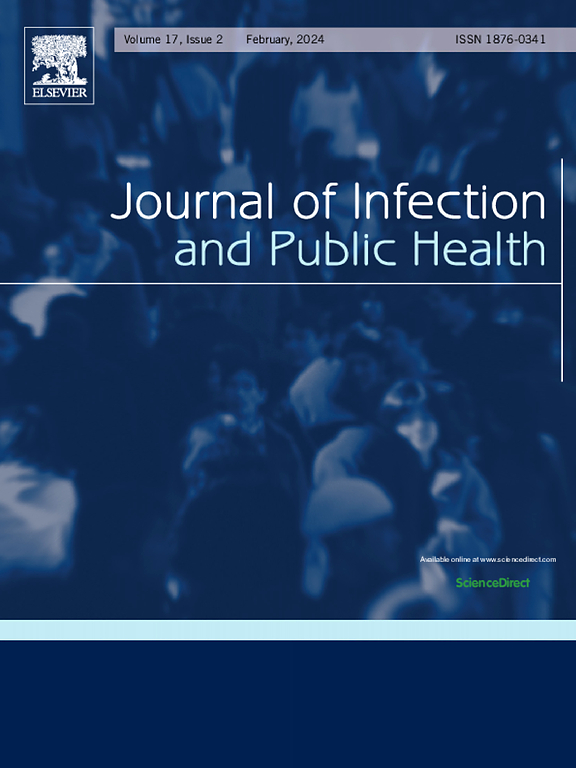Risk factors and locations of falls among older pilgrims during Hajj: Implications for targeted prevention
IF 4
3区 医学
Q1 INFECTIOUS DISEASES
引用次数: 0
Abstract
Falls are a major cause of morbidity and mortality among older adults, with risks heightened during physically demanding mass gatherings such as the Islamic Hajj. However, research addressing fall-related risks during Hajj remains limited. This study aimed to determine the prevalence, risk factors, and common locations of falls among older pilgrims. A cross-sectional survey was conducted during the 2024 Hajj among pilgrims aged ≥60 years. Data were collected through structured interviews using standardized questionnaires on demographics, medical history, fall occurrence, locations, and injuries. Logistic regression was used to identify independent predictors. Among 777 participants (median age 68.0 years; 60.2 % male), 39 (5.0 %) reported falls. Most occurred at high-density sites, especially Mena (46.2 %), followed by the Grand Mosque and Arafat (each 17.9 %). Falls occurred during the throwing of Jamarat, in bathrooms, and on stairs. Non-Saudi nationality (OR = 2.53, p = 0.010) and asthma (OR = 3.78, p = 0.005) were identified as independent predictors. Injuries occurred in 28.2 % of fallers, and 23.1 % required emergency care. Targeted interventions are essential, including pre-travel assessments, multilingual educational programs, improved infrastructure, and designated walking paths. Future studies should explore the feasibility of real-time surveillance systems to enhance fall detection and safety during Hajj.
朝觐期间老年朝圣者跌倒的危险因素和地点:有针对性预防的意义
跌倒是老年人发病和死亡的主要原因,在伊斯兰朝觐等体力要求较高的大型集会期间,跌倒的风险更高。然而,针对朝觐期间跌倒相关风险的研究仍然有限。本研究旨在确定老年朝圣者跌倒的患病率、危险因素和常见位置。对2024年朝觐期间年龄≥60岁的朝觐者进行了横断面调查。通过结构化访谈收集数据,使用标准化的人口统计、病史、跌倒发生率、地点和伤害调查问卷。使用逻辑回归来确定独立的预测因子。在777名参与者中(中位年龄68.0岁;60.2 %男性),39(5.0 %)报告跌倒。大多数发生在人口密集的地点,尤其是梅纳(46.2% %),其次是大清真寺和阿拉法特(各17.9% %)。在投掷Jamarat时,在浴室和楼梯上都会摔倒。非沙特国籍(OR = 2.53,p = 0.010)和哮喘(OR = 3.78,p = 0.005)被确定为独立预测因子。28.2% %的跌倒者受伤,23.1% %需要紧急护理。有针对性的干预措施至关重要,包括旅行前评估、多语言教育计划、改善基础设施和指定步行路径。未来的研究应探索实时监控系统的可行性,以提高朝觐期间的跌倒检测和安全。
本文章由计算机程序翻译,如有差异,请以英文原文为准。
求助全文
约1分钟内获得全文
求助全文
来源期刊

Journal of Infection and Public Health
PUBLIC, ENVIRONMENTAL & OCCUPATIONAL HEALTH -INFECTIOUS DISEASES
CiteScore
13.10
自引率
1.50%
发文量
203
审稿时长
96 days
期刊介绍:
The Journal of Infection and Public Health, first official journal of the Saudi Arabian Ministry of National Guard Health Affairs, King Saud Bin Abdulaziz University for Health Sciences and the Saudi Association for Public Health, aims to be the foremost scientific, peer-reviewed journal encompassing infection prevention and control, microbiology, infectious diseases, public health and the application of healthcare epidemiology to the evaluation of health outcomes. The point of view of the journal is that infection and public health are closely intertwined and that advances in one area will have positive consequences on the other.
The journal will be useful to all health professionals who are partners in the management of patients with communicable diseases, keeping them up to date. The journal is proud to have an international and diverse editorial board that will assist and facilitate the publication of articles that reflect a global view on infection control and public health, as well as emphasizing our focus on supporting the needs of public health practitioners.
It is our aim to improve healthcare by reducing risk of infection and related adverse outcomes by critical review, selection, and dissemination of new and relevant information in the field of infection control, public health and infectious diseases in all healthcare settings and the community.
 求助内容:
求助内容: 应助结果提醒方式:
应助结果提醒方式:


